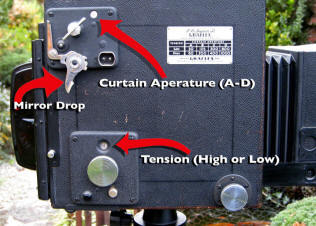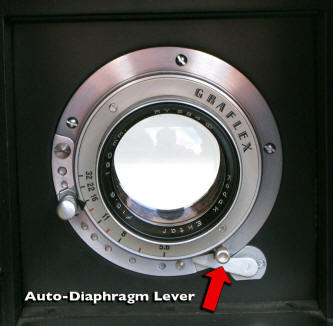Classic Camera Corner
 Using the RB
Super D Graflex Using the RB
Super D Graflex
by Graham Law, President, Seawood
Photo
December 2007
There aren’t many large
format cameras that that I would describe as spontaneous
or hand-holdable. Linhof Technikas, Speed Graphics,
Horseman Field cameras and their like are often used
unencumbered by a tripod.
All employ
an attached rangefinder or frame finder to view an
approximation of the image. If you want to use the
ground glass to see your actual image you must remove
the film holder, focus on an upside down and backwards
image, replace the film holder, and hope your subject
hasn’t moved and you are pointing your camera in the
same place…
Wouldn’t
it be cool if someone would invent a Single Lens Reflex
4x5? Well, of course someone did; Graflex started
selling their first version of the RB Graflex in 1923!
For over
ten years I’ve kept their best incarnation, a Graflex
Super D, behind the counter at Seawood Photo. I use it
primarily to take quick portraits of our customers,
sales reps and each other.
It suits
itself well to portraiture as I can set it up the
camera, pose the subject, and pack it all back up in
less than a minute or so. Might seem like a long time in
this digital age, but quite remarkable for a 4x5.
The large
leather handle on the top makes carrying the camera akin
to carrying a toolbox. Be careful, however, as the
leather on these older cameras is often brittle and most
of the S.D.’s we see are missing this handle. I’ve seen
people replace these with metal gate handles!
The lens
on my camera is a Kodak 190mm f5.6 Ektar. It has
reasonable contrast for a monocoated lens, and is very
sharp with a smooth bokeh. I usually shoot with it wide
open to take advantage of the format’s inherent lack of
depth of field. Looks nice!
The Super
D is a true SLR with many features one would expect with
modern medium-format cameras, such as:
- Automatic Diaphragming (their title). Early SLR’s would
require you to focus at wide-open aperture, then stop
down to the desired aperture to shoot. This meant you
were often looking at a dark image when the shot was
fired. With the Super D you choose your aperture, than
cock a lever on the lens that holds the diaphragm wide
open until the shutter is released.
- Rotating
Back
- Fast
Shutter Speeds. Top speed is 1/1000th!
- Interchangeable
Film Backs. I often use a Polaroid 545 holder for
instant B&W prints. The color shot for this article was
shot with a Graflex “23” 120mm rollfilm holder. This
gives you eight 6x9 shots per roll. (Earlier Super D’s
do not have a modern “Graflok” back, which means you
can’t use newer accessories such as Polaroid. The
earlier ‘Graflex” back system had similar options, but
it is becoming difficult to find holders and rollbacks.
(There is a company called S.K. Grimes that does machine
work and will convert your old style back to Graflok.
They will do both the 3-1/4 x 4-1/4 and 4x5 S.D.’s, plus
mount your lenses. See their website at
http://www.skgrimes.com)
The camera is
relatively simple to operate. To set the shutter speed
you first look at a chart riveted to the right side of
the camera. This tells you what “Curtain Aperture” (a-d)
and “Tension” level (High or Low) combination is needed
for the desired speed.


The Curtain
Aperture is set by winding the key on the upper left
until the letter indicated on the chart appears in a
small window. If you wind it too far there is a release
bar behind the key that allows you to back it down.
The tension level
knob on the bottom left is wound clockwise from “L” to
“H”. To get back to “L” push up on the button just below
the wind knob several times until the “L” indicator
shows in the window.
It’s a good idea to
store the camera with the tension level set to “L” as
this causes less strain on the mechanism.
The mirror must be
dropped down into position after each shot if you wish
to look through the camera. This is done by pulling back
on the mirror drop lever.
 The lens aperture
is set on the lens barrel. By pulling out on a button
you rotate an arrow until it aligns with the desired
f/stop. You then cock the lens (see photo) by moving the
auto diaphragm lever counter-clockwise until it catches,
allowing you to look through the lens at a nice, bright
f5.6! The lens aperture
is set on the lens barrel. By pulling out on a button
you rotate an arrow until it aligns with the desired
f/stop. You then cock the lens (see photo) by moving the
auto diaphragm lever counter-clockwise until it catches,
allowing you to look through the lens at a nice, bright
f5.6!
Finally, the camera
is fired by depressing a small lever on the left side of
the body.
SHOOTING WITH THE GRAFLEX
So what’s it like
to shoot one of these guys? For portraits and close
action this is a dream 4x5…for most other jobs it kind
of sucks! For starters, your slow speeds are limited to
1/30th and up. No f/32 landscapes with this puppy…
Lens choices are
very limited. You cannot use a wide angle lens at all
due to the body size.
There are no camera
movements at all (one of the best reasons to shoot 4x5).
I’m surprised they didn’t add rise/fall at the very
least.
Holding the Super D
is like holding a large box at your waist. There is
nothing ergodynamic about it. Maybe my UPS guy should
get one!
There is no
provision for a neck or shoulder strap either, which I
find strange for a hand-held camera.
Color photos could
use a bit more contrast, perhaps a later multicoated
Ektar version would give a bit more snap.
On the plus side,
black and white images are fantastic! Portraits have a
great glow about them, and it’s a fun camera to use.
I’ve picked up a 6x9 version with a rollfilm back that
will be easier to schlep around, and expect similar
results.
Super D’s are
usually priced around $700.00 or so. 2-1/4 x 3-1/4
versions generally go for around $4-500.00 with a
rollfilm back. Perhaps because they are a bit much to
lug around, many we see have seen little use; it is not
uncommon to see one in truly mint condition.
Here’s some
portraits taken with my Super D:
BACK TO CLASSIC CAMERA CORNER
INDEX > |



